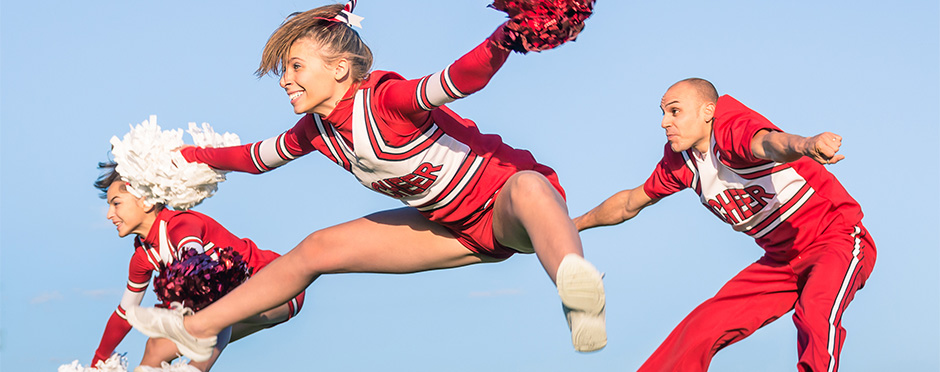
4 Ways Cheerleaders Can Get Higher Jumps
Leave a CommentMany cheerleaders want to achieve higher and more powerful jumps. Jumps take practice and repetition. Jumping also involves the whole body, requiring strength in your legs, hips, core, back, and upper body. These four focus areas may help you achieve your high jumping goals!
1. Flexibility
Stretching and overall flexibility are the basics of your jumps. Significant stretches to perform for any cheerleader include straddle stretch, pike stretch, splits, and hip flexor stretch.
Straddle Stretch
- Sit with legs wide apart in a V shape with toes pointed.
- Lean forward into the middle keeping your back straight and hold for 20-30 seconds.
- You can also perform reaching to the left or right leg.
- Perform 3 repetitions in each direction.
Pike Stretch
- Sit with legs straight forward, toes pointed.
- Lean forward, reach toward toes, keep back as straight as possible, and hold for 20-30 seconds.
- Perform 3 repetitions.
Split Stretch
- If you are working toward achieving your full splits, ease down into the stretch to the point where you feel a stretch in the front or back of your leg; use your hands for support.
- Make sure to keep your hips squared to the front and your back leg tucked under to avoid rotation in your hips. And always stretch on both sides.
- You can use pillows or yoga blocks underneath your body to assist with stretching while working on achieving a full split position.
- If you already have your full split, make sure you check to see if your hips are squared front, and there is minimal rotation, and the back foot is tucked underlying flat.
Hip Flexor Stretch
Stretching your hip flexors can help you achieve your splits easier and help with flexibility for other jumps.
- Begin in a kneeling position with one knee down and one leg up.
- Keeping your torso upright and your hips tucked underneath you, gently lean forward until a stretch is felt in the front of the hip and the knee that is on the floor.
- Hold for 20-30 seconds and repeat 3 times on each side. You can add reaching overhead to increase the intensity of the stretch.
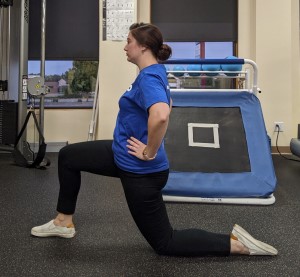
2. Strengthening in Functional Positions
It’s essential to improve your strength in positions related to the jumps you want to achieve. Start by strengthening in a smaller range of motion and then progress to a more extensive range.
Straddle Leg Lifts
- Begin by sitting in your straddle position on the floor.
- Lean back slightly; you can have hands on the floor in front of you for balance but try to keep your body reasonably upright.
- Try to lift your right leg off the ground a couple of inches and hold for 2-3 seconds. Then repeat on the left side.
- Keep your leg straight, and your toes pointed. Aim for sets of 5, to begin with, and perform 2-3 sets per side.
- If this becomes easy, you can begin to try lifting both legs off the ground simultaneously and hold for 2-3 seconds.
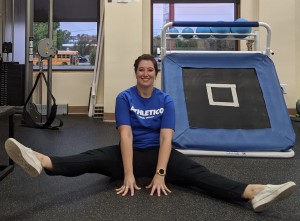
Resisted Kicks
- Place a resistance band around your ankles.
- Holding on to a chair, countertop, or bleacher, kick one leg to the front and then return. Focus on keeping the body upright and avoid leaning.
- Perform 10 reps.
- Then kick to the side by rotating your leg outward so that your knee points to the ceiling. Lift the leg up to hip level, then return. Perform 10 reps.
- Then kick your leg to the back keeping your hips square, and return. Perform 10 reps.
- Remember to adjust your resistance band length to allow the range you are trying to get to, and it is not too short or too long.
- Perform 2-3 sets of 10 repetitions in each direction and on each leg.
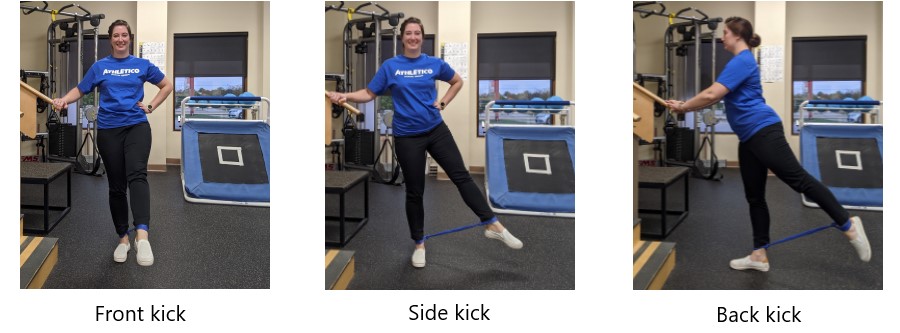
3. Jump Training
Working on double-leg jumps will help improve the height of your jumps and allow you to practice a safe landing technique.
Jump Squats
- Start in a squat position with feet shoulder-width apart.
- Spring up as quickly as possible and return to starting squatted position.
- Remember to land with knees bent and use your arms to help give you the power and height to your jump. This is similar to how your arms help when performing cheer jumps.
- Perform 10 repetitions and aim for 3 sets. Remember to sit back into your squat as if sitting in a chair upon landing and keep your landings quiet- this requires more muscle control.
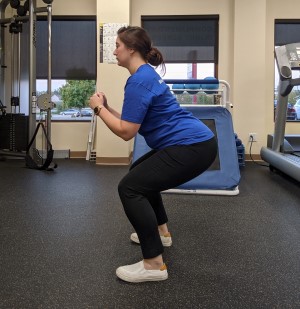
4. Jumping Drills
These are several jumps performed in succession to improve coordination, timing, and endurance which is needed to complete your cheer routine. Jumps require a lot of energy and power. You want to make sure your body is ready to perform jumps just as good when you are tired at the end of your routine as it is at the beginning of your routine. Conditioning with plyometric drills can help with this. Plyometrics is a type of training using exercises where muscles exert maximal force quickly to increase the power.
Types of plyometric jumps:
Square Hops
- Use tape to make a cross, so you have 4 one-foot square boxes.
- Hop from box to box over the lines with feet together.
- Perform clockwise, counterclockwise, diagonals, and then progress to one foot at a time.
- Perform for 30 seconds 3 sets with a rest break in between.
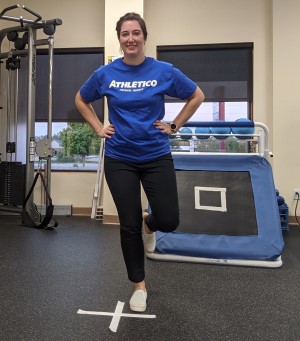
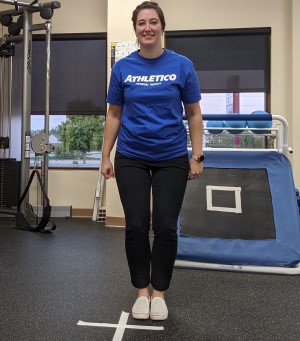
Box Jumps
- Explode up off the ground from a squatted position and land on top of the box and try to land as softly and as quietly as possible.
- Box height can begin at about 6 inches off the floor and progress upward depending on the athlete.
- Again, when jumping down from the box, make sure to land with knees bent into a squatted position and land as softly and quietly as possible.
- Perform for 30 seconds and repeat 3 times.
- You can also begin to perform single leg as you get stronger.
- Remember to use your arms to help with your jumps, similar to how your arms help you with your specific cheer jumps!
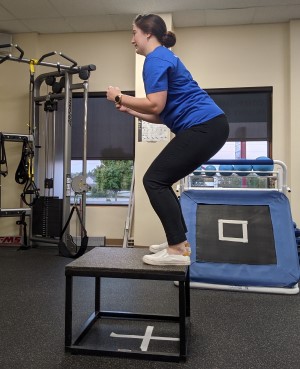
Broad Jumps
- Perform several squat jumps in a row, jumping as far as you can forward and landing with good technique with your hips, knees, and ankles shoulder-width apart, knees bent, and trunk upright.
- Perform 10 jumps forward. Then perform 10 jumps backward, working on maintaining good take-off and landing positions.
- Then perform jumps sideways for 10 jumps in one direction, then return to the starting point with ten more lateral jumps.
Summary
Athletico provides rehabilitation services in-clinic and via telehealth to cheerleaders at all levels and abilities. Our goal is to evaluate, treat, and educate athletes to prevent practice and competition-related injuries. We have physical therapists and athletic trainers, including former gymnasts and cheerleaders at our Gymnastics and Cheerleading Program at the high school, collegiate, and Olympic levels. Our clinicians understand the demands of the sport and use their personal and professional experience to address each athlete’s physical and psychological needs effectively.
Find a Gymnastics/Cheerleading Specialist Near You
The Athletico blog is an educational resource written by Athletico employees. Athletico bloggers are licensed professionals who abide by the code of ethics outlined by their respective professional associations. The content published in blog posts represents the opinion of the individual author based on their expertise and experience. The content provided in this blog is for informational purposes only, does not constitute medical advice and should not be relied on for making personal health decisions.
